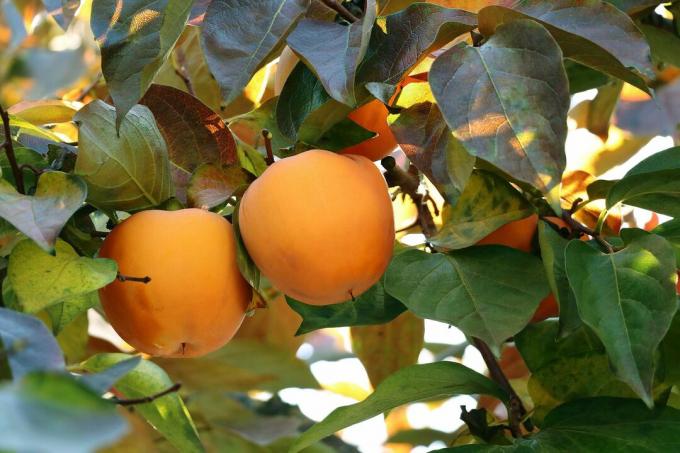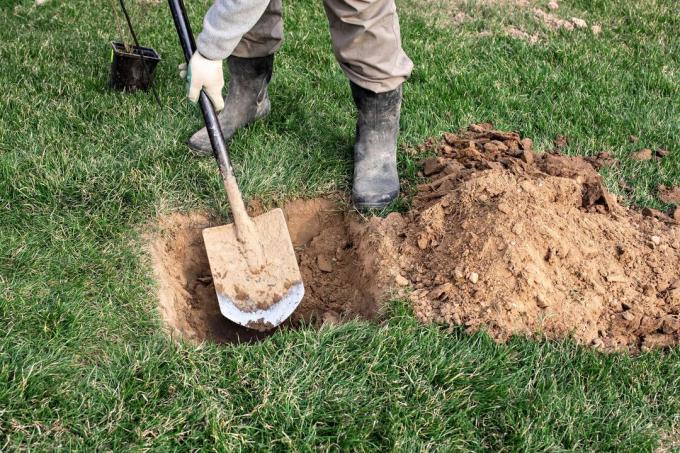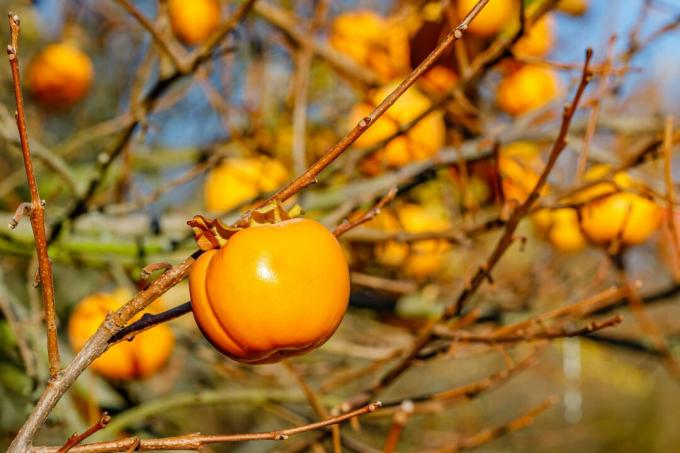Persimmon trees can survive and bear fruit even in our temperate latitudes. We will show you how to properly plant and care for your persimmon tree.

The persimmon (Diospyros kaki) brings variety and a touch of exoticism to your garden. It is true that persimmon trees are traditionally cultivated in tropical and subtropical regions; But if you pay attention to a few tips on cultivation and care, you can soon be harvesting your own persimmons. In our article we tell you everything about the origin, variety recommendations, planting and care of persimmon trees and give tips on harvesting the delicious persimmons.
contents
- Persimmon Tree: Origin & Properties
- Buying a persimmon tree: you need to pay attention to this
- Popular and good tasting persimmon varieties
-
Planting a persimmon tree: Instructions in 4 steps
- 1. Choose the right time to plant the persimmon tree
- 2. Choose a suitable location for the persimmon tree
- 3. Dig a hole large enough for the persimmon tree
- 4. Fill the hole with soil and water the persimmon tree well
- Propagating persimmon trees: grow them yourself from seeds
-
Maintain persimmon tree
- Pour and fertilize the persimmon tree
- Cutting a persimmon tree: when and how to do it
- Overwinter persimmon tree
-
Harvesting and storing persimmons
- When are persimmons ripe?
- How to store persimmons?
Persimmon Tree: Origin & Properties
The persimmon tree belongs to the genus of ebony trees (Diospyros) and thus to the ebony family (Ebenaceae). The genus name Diospyros means something like the divine fruit or food of the gods. Other names for persimmons are date plum, Chinese plum, god plum, honey apple or persimmon apple. With the plum (Prunus domestica) the persimmon is not remotely related.
Persimmons have been cultivated in China for over 2000 years, making them one of the oldest cultivated plants in the world. Because persimmons have a very soft flesh and are therefore only transportable to a limited extent, it was not until the 18th The first persimmon trees were planted in southern Europe in the 19th century. Today, the main growing regions for kakis are still in China, but also in Spain, Italy and Israel.
Under ideal conditions, the kaki tree can grow up to ten meters high. From afar, its growth form reminds of an apple tree. The bark is brown and coarsely scaly. The alternate leaves are larger and coarser than apple tree leaves and have a smooth, glossy surface. They are usually ovoid, rarely heart-shaped. In autumn they turn a beautiful orange to red. The tree starts flowering from late spring to early summer. There are both monoecious and dioecious persimmon trees. The female flowers usually appear solitary and are fourfold and yellow. The male flowers are smaller and usually found in clusters of four to five.

The female flowers develop into spherical berries, five to eight centimeters in size, which are reminiscent of tomatoes in shape. The fruits have a smooth, shiny skin and turn bright orange when ripe. The soft pulp can contain up to eight seeds. Still unripe, kakis contain a lot of tannin and are therefore strongly astringent. This means that everything in the mouth contracts when eaten and the fruit tastes very tart. As the fruit matures, the flesh becomes softer and the skin becomes almost transparent. Then the taste of the fruit is reminiscent of a mixture of pear (Pyrus) and apricot (Prunus armeniaca), and she's wonderfully cute.
Buying a persimmon tree: you need to pay attention to this
When buying, you should consider a few points so that you can enjoy your tree for as long as possible. First of all, the choice of variety is very important, because it not only determines the nature of the fruit that you will later harvest, but also the location requirements of the tree. Frost-tolerant varieties are necessary for outdoor cultivation, while potted plants can also move to a warm place in winter. Another important point is the age and size of the tree. The larger the tree, the more expensive it is of course. But larger trees can be transplanted into the open ground more quickly, and they also bear fruit earlier.
You should pay attention to this when buying a persimmon tree:
- strain choice
- age and size of the tree
- Vital growth
- Good health
- No rotten roots
You can buy persimmon trees from nurseries and garden centers. Or you can look around the internet for a suitable tree for yourself. A large selection of kaki varieties can be found at plant spec or the Nursery and Vine Nursery Schreiber.
Popular and good tasting persimmon varieties
Not all persimmons are the same, because after their arrival in Europe, persimmons were cultivated further and further. Today, a distinction is made between kaki, persimmon and sharon. Persimmons are the original fruit that must first fully ripen before the fruit becomes soft and edible. Persimmons come from Spain and have the advantage that they are no longer astringent and taste good even when hard. The same applies to the Sharon fruit from Israel.
More about the Differentiation between kaki, sharon and persimmon you can read here.
There are around 500 different kaki varieties worldwide, most of which can be found in Asia. But persimmons can also thrive here if varieties with frost tolerance are selected. Here we present some promising persimmon varieties for cultivation in temperate climates.
Recommended persimmon varieties for temperate climates:
- ˈAromaˈ: This variety produces soft, orange fruits that taste sweet and juicy.
- ˈCioccolatinoˈ: This variety forms large, yellow fruits with a great aroma.
- ˈEarly Fuyuˈ: Early-ripening variety that is best suited to temperate climates. The fruits are sweet and have firm flesh.

- ˈJiroˈ: The fruits of this variety are very large and the skin is yellowish. When ripe, the persimmons are firm and not astringent.
- ˈKuro Gakiˈ: This variety is very special because it bears small, pointed fruits with a blue skin. The flesh is orange and sweet.
- ˈmeanderˈ: The fruits of this American variety are small and flat.
- ˈNikita's Poisonˈ: This persimmon variety is well adapted to our climate. It also boasts a particularly sweet, intense taste.
- ˈPrairie Dawnˈ: This variety is a new breed and is characterized by its hardy and particularly sweet fruits. However, these are small.
- ˈRojo Brilliantˈ: This classic persimmon variety from Spain can also be grown here. The fruits impress with their sweet taste.
- ˈRosseyankaˈ: This new breed from Russia produces large, sweet fruits that have almost no seeds.
- ˈTipoˈ: This variety is particularly popular in Italy. The fruits are particularly large and soft.
- ˈVainigliaˈ: This new variety is characterized by its vanilla scent.
Planting a persimmon tree: Instructions in 4 steps
Planting the persimmon tree is usually very simple. If you follow the 4 steps we have described, nothing should go wrong.
1. Choose the right time to plant the persimmon tree
In the first three to four years, the persimmon tree cannot survive the winter outside. Therefore, until it is old enough, it is cultivated in pots. If the tree is old and big enough, it can be planted in the garden in spring. Then it has the entire growing season to establish itself. There should also be no more frost when you plant it.
2. Choose a suitable location for the persimmon tree
The persimmon tree is a warmth-loving plant and should therefore be planted in a location that is as sunny and bright as possible. House walls on the south side, for example, are ideal. It is also important that the location is as sheltered from the wind as possible. The persimmon tree does not make particularly high demands on the soil. It should be as loose and permeable as possible. Sandy-loamy soils with a high content of humus and nutrients are ideal. The tree feels most comfortable with a neutral pH value.

At a glance: where should you plant a persimmon tree?
- Especially sunny
- sheltered from the wind
- Loose, well drained soil
- Rich in humus and nutrients
- pH neutral soil
- Planting distance to other trees: 4 meters
3. Dig a hole large enough for the persimmon tree
The planting hole for your persimmons should be twice the diameter and twice the depth of the plant container. The tree should only be planted there as deep as it was in the container. To give the tree the best possible start, loosen the soil well before planting and remove all stones. Now enrich the soil with organic material such as compost or a fertilizer with a long-acting organic effect. Our Plantura organic tomato fertilizer is ideally suited for basic fertilization of your persimmon tree.
4. Fill the hole with soil and water the persimmon tree well
Once the tree has been placed in its planting hole, fill the hole with the excavation and water the sapling copiously.
Step-by-step instructions: plant a persimmon tree
- loosen soil
- Amend the soil with compost or a slow release organic fertilizer
- Dig a planting hole
- Planting hole should be twice as large and deep as plant containers
- Only put the tree as deep in the hole as it was in the container
- Fill the hole with soil
- Water well
You will learn how to properly care for your persimmon tree after planting later in this article.

Propagating persimmon trees: grow them yourself from seeds
If you want to propagate your persimmon tree yourself, you can do so through seeds. However, fruits bought from the supermarket are not suitable for propagation. If you don't have a persimmon tree yet and would like to grow one from seeds, you should order seeds from specialist retailers. Seeds from self-harvested fruits must first be stratified before sowing, i.e. the germination inhibition is removed. To do this, the cleaned seeds are placed in a bag with moist sand in the refrigerator for three months.
After that, the seeds are ready for planting. Prepare a container with potting soil for this. The seeds are now placed on the substrate and only slightly covered with soil and moistened. To create a good climate for germination, pull a plastic film over the planter or place it in it homemade mini greenhouse. In a light and warm place, at 20 to 22 degrees, the seeds should germinate within two to four weeks. Of course, they have to be moistened regularly for this. A spray bottle is best for this. After the first leaves have formed on the seedlings, they can then be separated and transplanted into larger pots. It can take ten to twelve years for the persimmon trees you grow to bear fruit for the first time.
Summary: How to propagate a persimmon tree?
- Buy seeds in specialist shops or take them from your own tree
- Stratify your own seeds
- Fill the planter with potting soil
- Place seeds on the substrate and cover lightly with soil
- moisten
- Put plastic wrap over the jar or put it in a mini greenhouse place
- Light and germinate at 20 – 22 °C
- Moisturize regularly
- Germination period: 4 weeks
- After the first leaves have formed, repot

Maintain persimmon tree
In order for your persimmon tree to grow and thrive, you should take proper care of it. We'll tell you everything about watering, fertilizing, cutting and overwintering your persimmons.
Pour and fertilize the persimmon tree
The water requirement of the kaki is not very high. In the pot, the plant is of course dependent on regular watering. However, you should definitely avoid waterlogging. Outside in the garden, your tree should only be watered during a real dry spell, as too much water can affect fruit formation. You should also be careful with fertilizers, because over-fertilization can have a negative effect on frost tolerance. In the first month after planting, you should not fertilize at all. After that, you can fertilize from May to the end of July. Potassium-rich fertilization is important for fruit formation. Our Plantura organic tomato fertilizer with an organic long-term effect provides all the important nutrients for your persimmon tree and releases them gently and slowly to the tree. So your persimmon is well supplied with fertilizer.
At a glance: How is the persimmon tree properly watered and fertilized?
- Water the pot regularly, but avoid waterlogging
- During the winter in the pot, water only once a month
- Only water the garden during dry periods
- Do not fertilize in the first month after planting
- Fertilize with a high potassium content from May to the end of July
Cutting a persimmon tree: when and how to do it
Persimmon trees do not require regular pruning. If you still reach for the pruning shears from time to time, he won't take offense, however, because persimmon trees are very tolerant of pruning. The best time for pruning is in winter, from late February to early March. Young trees can be steered in the right direction for growth with a topiary. A popular growth form, for example, is a central shoot with three to four strong side shoots. In order not to let the tree grow too tall, you can also shorten long annual shoots by half.

Pruning a persimmon tree at a glance:
- Persimmons are very tolerant of pruning
- Prune late February - early March
- Training pruning on young trees
- Occasionally shorten long annual shoots by half
Overwinter persimmon tree
Young persimmon trees must be overwintered indoors, the same applies to potted plants. The winter quarters should preferably be dark and not warmer than five degrees. In winter, the tree then sheds its leaves and requires almost no attention. If no more frost is to be expected in spring, the tree can move back outside. Persimmon trees outside in the garden should be protected from frost by a thick layer of mulch in the root area. Leaves or bark mulch are suitable for this, which is also covered with brushwood. Trees that are still young can also be protected with fleece or jute bags around the shoots. The antifreeze is then removed again in the spring.
At a glance: Overwinter the persimmon tree properly
- In the bucket, dark, at max. 5°C
- Water little, do not fertilize
- Mulch thickly in the root area outdoors
- Protect shoots with fleece or jute
Harvesting and storing persimmons
Autumn is finally the time to harvest and you can enjoy the delicious, sweet fruits.
When are persimmons ripe?
From October, kakis are ready for harvest. By then, the tree has usually shed its leaves. However, let the fruit ripen on the tree for as long as possible. You should harvest them at the latest when the first frost is to be expected. It depends on the variety whether the persimmons are soft or hard when they are fully ripe. Persimmons must be very soft so that they no longer taste bitter and astringent. Sharon and persimmons can be eaten with hard flesh.

How to store persimmons?
You can store persimmons for up to two weeks in a cool place, such as the refrigerator or cellar. If the fruits are not yet fully ripe on the tree, they can ripen later. This works together with other fruit such as apples or pears in a foil bag at 15 °C. The fruit should ripen within two weeks. Or you can put the fruit in the freezer for 24 hours.
The persimmon tree is just one of many exotic fruit trees. In our special article we provide you with more 10 unknown types of fruit in front.



